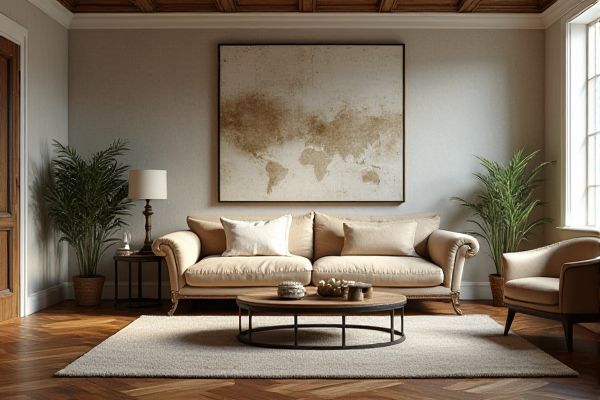
A distressed finish offers a rustic, aged appearance with intentional imperfections, creating a vintage or worn look, while a polished finish provides a smooth, glossy surface that enhances elegance and modernity. Discover the practical benefits and aesthetic impacts of both finishes to determine which best suits your style and space.
Table of Comparison
| Feature | Distressed Finish | Polished Finish |
|---|---|---|
| Appearance | Worn, rustic, aged look | Smooth, shiny, reflective surface |
| Texture | Rough, uneven | Smooth, sleek |
| Durability | Conceals scratches, less maintenance | Prone to visible scratches, requires regular care |
| Common Uses | Vintage, farmhouse, rustic decor | Modern, contemporary, formal settings |
| Material Suitability | Wood, metal, leather | Marble, glass, metal, hardwood |
| Cost | Generally lower to moderate | Moderate to high |
| Maintenance | Low; scratches blend naturally | High; requires polishing and cleaning |
Introduction to Furniture Finishes
Distressed finishes create a weathered, vintage look by simulating wear and tear, adding character and a rustic appeal to your furniture. Polished finishes offer a smooth, glossy surface that enhances the wood's natural grain, providing a sleek and modern aesthetic. Choosing between these finishes depends on your desired style and the ambiance you want to achieve in your living space.
What Is a Distressed Finish?
A distressed finish is a surface treatment technique that intentionally ages or wears materials like wood, metal, or furniture to create a vintage or rustic appearance. This finish often involves sanding, scraping, or applying stains to mimic natural wear and tear, adding character and texture. Unlike a polished finish, which is smooth and reflective, a distressed finish emphasizes imperfections and a weathered look.
What Is a Polished Finish?
A polished finish is characterized by its smooth, reflective surface achieved through fine abrasive polishing techniques that enhance the material's natural color and texture. This finish is commonly applied to marble, granite, and engineered stone, providing a sleek, high-gloss appearance ideal for countertops and floors. Your choice of a polished finish offers ease of cleaning, stain resistance, and a sophisticated aesthetic that contrasts sharply with the textured, rustic look of a distressed finish.
Key Differences Between Distressed and Polished Finishes
Distressed finishes feature intentional wear, scratches, and imperfections that create a vintage or rustic appearance, emphasizing texture and character. Polished finishes are smooth, glossy, and reflective, highlighting sleekness and a modern aesthetic through meticulous buffing and sealing. The key differences lie in their visual impact, texture, and the emotional response they evoke, with distressed finishes offering warmth and authenticity, while polished finishes convey elegance and sophistication.
Aesthetic Appeal: Rustic vs. Modern Styles
Distressed finishes showcase a rustic aesthetic with weathered textures and imperfections that evoke a vintage, cozy atmosphere, ideal for traditional or farmhouse interiors. Polished finishes create a sleek, reflective surface that complements modern, minimalist styles through clean lines and a refined look. Your choice between these finishes directly impacts the room's ambiance, balancing warmth with sophistication.
Durability and Maintenance Comparison
Distressed finishes offer enhanced durability due to their textured surface, which better conceals scratches and wear over time, making them ideal for high-traffic areas. Polished finishes, while visually striking with their smooth, reflective surfaces, require more frequent maintenance to prevent visible scratches, stains, and dulling. Choosing between the two depends on balancing the ease of upkeep with the desired aesthetic longevity.
Best Applications for Distressed Finishes
Distressed finishes are best applied in rustic, vintage, or farmhouse-style interiors where an aged, weathered look enhances the character and warmth of the space. They work well on wood furniture, cabinetry, and flooring, providing a tactile texture that conceals wear and adds visual depth. Ideal for high-traffic areas, distressed finishes hide scratches and dents better than polished finishes, making them practical as well as aesthetically appealing.
Ideal Uses for Polished Finishes
Polished finishes are ideal for high-traffic areas such as kitchens, bathrooms, and commercial spaces due to their smooth, reflective surface that enhances light and aesthetics. They provide a sleek, modern look and are easier to clean and maintain, making them suitable for environments requiring hygiene and style. Polished finishes are also preferred for countertops and flooring where a sophisticated appearance and durability are essential.
Cost Considerations: Distressed vs. Polished
Distressed finishes generally incur lower costs due to less labor-intensive application and the use of fewer high-end materials, making them budget-friendly for rustic or vintage aesthetics. Polished finishes require more precise craftsmanship, specialized equipment, and often premium materials, resulting in higher overall expenses. Your choice depends on balancing desired style with project budget constraints, where distressed offers economical appeal and polished demands premium investment.
Which Finish Should You Choose?
Choosing between a distressed finish and a polished finish depends on your desired aesthetic and lifestyle needs. Distressed finishes provide a rustic, vintage charm with a textured look that hides wear and tear, perfect for casual or farmhouse styles. Polished finishes offer a sleek, reflective surface that enhances modern and upscale interiors while being easier to clean, making it ideal for high-traffic or formal spaces where you want your surfaces to shine.
 homyna.com
homyna.com